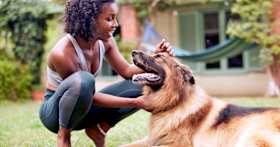Rottweiler vs. Doberman: Which Is Right for You?
From their temperaments to needs, we help you weigh the differences between these two exceptional breeds (and breed mixes).
From their temperaments to needs, we help you weigh the differences between these two exceptional breeds (and breed mixes).
by Mollie Jackman, | January 31, 2025

Alexandra Kruspe / Shutterstock
Curious whether a Rottweiler or Doberman is the right breed for you? Both of these loyal, intelligent, and attentive dogs make excellent companions, but they have distinct differences. Rottweilers are known for their calm, affectionate nature and strong bond with their families, while Dobermans are admired for their sleek, athletic build, energetic personality, and sharp intelligence.
This guide will compare the traits of each breed, including their temperaments, care needs, and ideal living environments, to help you determine which dog is the best fit for your lifestyle.
If you’re choosing between adopting a Rottweiler and a Doberman, understanding the key differences between these popular dog breeds can help you decide which best suits your home and lifestyle. Here’s a quick side-by-side comparison of the two.
Trait | Rottweiler | Doberman |
|---|---|---|
Size | Larger, 23 to 27 inches at the shoulder; 95 (female) to 135 pounds (male) | Leaner, 24 to 28 inches at the shoulder; 60 (female) to 100 pounds (male) |
Build | Thick and muscular | Slim and athletic |
Lifespan | 8 to 10 years | 10 to12 years |
Coat | Short, thick double coat | Short, sleek coat |
Energy Level | Moderate energy | High energy, requires frequent exercise |
Disposition | Laid-back and easygoing | High-strung and excitable |
Temperament | Calm, confident, affectionate | Energetic, loyal, alert |
Breed size: Rottweilers tend to be 95 to 135 pounds, with a muscular build. They have broad chests and sturdy frames, giving them a strong and imposing appearance. In contrast, Dobermans are lighter and more athletic, weighing 60 to 100 pounds. They have sleek, refined appearances with long, lean legs and graceful gaits.
Lifespan: Dobermans tend to live slightly longer than Rottweilers, with average lifespans of 10 to 12 years, while Rottweilers typically live eight to 10 years.
Coat and grooming: Rottweilers have thick double coats that require occasional grooming, especially during shedding season. Their short, dense fur is generally black and tan. Dobermans have short, smooth coats that are easy to maintain with regular brushing.
Energy and exercise needs: Rottweilers are generally more relaxed, needing moderate exercise such as daily walks and playtime. Dobermans, on the other hand, are highly energetic and thrive on regular exercise, including running and mental stimulation.
While both breeds are loyal, they require different degrees of physical activity and grooming. Understanding these differences can help you make the right choice for your family.
Rottweilers and Dobermans have their differences, but they share many qualities which make them both wonderful companions. Here are a few reasons why they make wonderful pets.
Both Rottweilers and Dobermans are incredibly loyal family dogs. They form strong bonds with their pet parents and are known for their devotion and affection. They tend to be especially good at recognizing and responding to their human companions, making them great pets for people seeking an emotionally connected dog.
Thanks to their smarts, Rottweilers and Dobermans both excel in training. Their ability to learn commands quickly and follow directions makes them popular choices for anyone looking for a trainable pup. However, their intelligence also means they require mental stimulation to avoid boredom.
Both breeds are alert and tend to be wary of strangers, which means they can make excellent watchdogs. Their attentiveness and loyalty often make them receptive to training, but it’s important to note that they are also affectionate pets who love spending time with their families.
Rottweilers and Dobermans are both highly trainable dogs, thanks to their eagerness to please and sharp minds. They both require clear, consistent training using positive reinforcement. In fact, they thrive in environments where they are given consistent training and socialization from a young age. Training a Doberman may take slightly more effort due to their high-energy personalities, but their eagerness to please makes up for the challenge.
Rottweilers and Dobermans are both wonderful family companions. Both are known to be gentle and loving, especially with their close family members, and they thrive on spending time with their people. Their loyalty, intelligence, and ease of training make them popular choices for active families and individuals looking for a loving, reliable pet.

Shchus / Shutterstock
Rottweilers and Dobermans both come with beautiful physical traits. Here’s a detailed breakdown of their builds, which may help you determine which breed is the right fit for you.
Rottweilers are large, muscular dogs with robust, solid builds. Their strong presence and sturdy frames give them an imposing yet calm demeanor.
Size: 75 to 135 pounds, medium to large, stocky build
Build: muscular with a broad chest and thick neck
Coat: short to medium-length, dense, double-layered coat
Color: typically black with tan markings
Movement: strong and powerful, but surprisingly agile for their size
Shedding: moderate shedding, especially during seasonal changes
Dobermans are sleek and athletic, known for their graceful movements. Their slim, muscular builds give them a sharp and refined look.
Size: 60 to 100 pounds, slim, athletic build
Build: sleek, streamlined body with long, slender legs
Coat: short, smooth coat
Color: black, blue, fawn, or red
Movement: graceful and swift, ideal for running and agility
Shedding: minimal shedding, easy to maintain
When it comes to personality, Rottweilers and Dobermans share qualities such as loyalty and intelligence, but they each have unique ways of interacting with their families. Let’s check out their temperaments to see which might be the better fit for your home.
Rottweilers tend to be calm, confident, and affectionate in temperament. They are family-oriented dogs who form strong bonds with their pet parents. Their instincts make them excellent companions, but they are also gentle giants.
Temperament: calm, confident, and affectionate
Bonding: strong attachments to their families
Alert: naturally alert and observant
Interaction: good with children and families when properly trained
Energy: moderate energy levels, requiring daily walks and playtime
Socialization: needs early socialization to avoid over-protectiveness
Dobermans are energetic, intelligent, and alert in temperament, known for their keen senses and playful nature. They form strong bonds with their families, though they tend to be more independent than Rottweilers.
Temperament: energetic, intelligent, and alert
Bonding: forms strong bonds with family, but may be more independent
Attentive: highly attentive, can be reserved or suspicious of strangers
Interaction: great with children and active families, requires regular play and exercise
Energy: high energy levels, needs lots of exercise and stimulation
Socialization: requires early socialization to manage their alert nature around strangers
Both breeds offer wonderful qualities as family pets, but their temperaments can be quite different. If you’re an active household, you may opt for a Doberman. But if you prefer a more gentle, relaxed household companion, a Rottweiler could be the right choice.

Rita Kochmarjova / Adobe Stock
Choosing the right breed also means considering the care and lifestyle requirements for each dog. Rottweilers and Dobermans are both highly intelligent and active breeds, but they have different needs when it comes to exercise, grooming, and environments.
Rottweilers are known for their calm demeanors, but they still require regular exercise to stay healthy and happy. While they might not have the same high-energy demands as Dobermans, they are still an active breed and benefit from daily walks, playtime, and mental stimulation.
Exercise needs: Moderate — daily exercise and playtime will help keep your Rottweiler happy and fit. They enjoy activities that engage both their minds and bodies.
Grooming: Low to moderate — their short coat requires minimal grooming, but regular brushing will help reduce shedding and keep their coat healthy. Expect heavier shedding during seasonal changes.
Living environment: Rottweilers do well in homes with yards where they can play and roam. They are adaptable but do best in homes where they are given plenty of attention and exercise. These dogs thrive with families who can provide structure and regular activities.
Training needs: Consistent training is essential to bring out the best in a Rottweiler. Early socialization and positive reinforcement help them become well-rounded dogs.
Dobermans have high energy levels and need more intensive exercise to stay healthy and content. They often end up in shelters because families underestimate their energy levels, so that’s an important consideration if you’re thinking of adopting this breed. They thrive in active environments where they can run, play, and engage with their pet parents. Dobermans also require regular grooming and mental stimulation.
Exercise needs: High — Dobermans need daily vigorous exercise, including running, walking, and interactive play. They benefit from activities that challenge them physically and mentally.
Grooming: Low — their short coat, which sheds minimally, is easy to maintain with regular brushing. Bathing should be done as needed.
Living environment: Dobermans are best suited for active households with enough space to run and play. A large backyard is ideal. But as long as they get plenty of exercise, they can adapt to various living situations. They thrive in homes where they are an integral part of the family dynamic and receive plenty of attention.
Training needs: Dobermans are intelligent and eager to please, so they excel in training. However, they require consistent training and socialization from an early age to ensure they are well-mannered and confident around strangers.
Both Rottweilers and Dobermans need regular exercise, mental stimulation, and proper training to be happy, healthy companions. However, the level of intensity in their exercise and grooming requirements differs, so consider your ability to meet these needs when deciding which breed is right for your lifestyle.
When deciding between a Rottweiler and a Doberman, it’s helpful to weigh the pros and cons of each breed for your lifestyle. Here’s a simplified breakdown to help you make an informed decision.
If you’re thinking about getting a Rottweiler, here are a few things to consider.
What to expect | What to keep in mind |
Affectionate and family-oriented: Rottweilers form strong bonds with their families and are great with children. | Requires consistent training: Rottweilers need an attentive family and consistent training. They require early training and socialization, using positive reinforcement or professional obedience classes. |
Moderate energy levels: Rottweilers are ideal for families who want an active but not overly demanding dog. | Moderate shedding: Rottweilers need regular brushing, especially during shedding seasons. Brushing one to two times a week, with regular vacuuming to manage shedding. |
Watchful and alert: Rottweilers are excellent watchdogs with natural instincts. | Space requirements: Rottweilers do best in homes with yards. They need daily walks, playtime, and mental stimulation, especially in apartments. |
Calm and confident: Rottweilers are calm, confident dogs who tend to stay composed in various situations. | Can be overprotective: Rottweilers may become overly protective if not properly socialized. Early socialization with various people, animals, and environments can keep them well-mannered. |
If you think a Doberman might be more your style, here are a few things to weigh.
What to expect | What to keep in mind |
Energetic and playful: Dobermans are perfect for active families who enjoy outdoor activities and physical exercise. | High exercise needs: Dobermans require vigorous daily exercise such as daily runs, walks, and active playtime, including sports like agility or fetch. |
Highly trainable: Dobermans are intelligent and eager to please, excelling in obedience and agility training. | Separation anxiety: Dobermans can become anxious if left alone for long periods. Comfort them with gradual acclimation to being alone, interactive toys, or even a pet sitter. |
Loyal and alert: Dobermans have a strong instinct of loyalty, which makes them excellent family guardians. | Space requirements: Dobermans are better in homes with a large yard. If in an apartment, needs extra exercise through walks, hikes, and dog park trips. |
Graceful and agile: Dobermans have an athletic build that makes them ideal for running and agility activities. | Prone to hyperactivity: Dobermans may develop behavioral issues without enough stimulation. Provide them with exercise, puzzle toys, and obedience training to prevent hyperactivity. |
A note on protective dogs: If you’re looking for a dog to provide peace of mind, it’s all about proper training and care. Some breeds are naturally more attentive and responsive, making them great companions for keeping an eye on things. But remember, no dog thrives when left outside alone, regardless of their role.
Being protective doesn’t mean being aggressive. With the right training and a loving, stable environment, dogs can be attentive and confident without crossing the line into unwanted behavior.
Rottweilers are generally a better choice for first-time dog parents due to their calmer nature. But both breeds require firm training and socialization.
Both Rottweilers and Dobermans can be great with kids, but Rottweilers tend to be calmer, while Dobermans may have more energy and require extra supervision around younger children.
Dobermans typically live longer, with an average lifespan of 10 to 12 years, while Rottweilers live around eight to 10 years.
Dobermans are often easier to train due to their eagerness to please, while Rottweilers may require more consistent leadership and structure.
Both breeds are excellent dogs, but the best choice depends on your lifestyle: Rottweilers are calmer and family-oriented, while Dobermans are energetic and highly trainable.
“Doberman Pinscher | Temperament & Facts.” Encyclopedia Britannica, www.britannica.com/animal/Doberman-pinscher.
Hart, Benjamin L, and Lynette A Hart. “Behavioral Profiles of 80 Breeds and Guidelines for Ages to Spay or Neuter.” Elsevier EBooks, 1 Jan. 2023, pp. 59–293, https://doi.org/10.1016/b978-0-323-99194-0.00008-9. Accessed 13 Feb. 2024.
Korres, Nicholas E., et al. “Effects of Salinity on Rice and Rice Weeds.” Advances in Rice Research for Abiotic Stress Tolerance, 2019, pp. 159–176, https://doi.org/10.1016/b978-0-12-814332-2.00008-3. Accessed 27 Nov. 2021.
Ogata, Niwako, et al. “Brain Structural Abnormalities in Doberman Pinschers with Canine Compulsive Disorder.” Progress in Neuro-Psychopharmacology and Biological Psychiatry, vol. 45, Aug. 2013, pp. 1–6, https://doi.org/10.1016/j.pnpbp.2013.04.002. Accessed 6 Mar. 2019.
“Rottweiler | Description, Temperament, Images, & Facts | Britannica.” www.britannica.com, www.britannica.com/animal/Rottweiler.
Van der Borg, Joanne A. M., et al. “Behavioural Testing Based Breeding Policy Reduces the Prevalence of Fear and Aggression Related Behaviour in Rottweilers.” Applied Animal Behaviour Science, vol. 195, 1 Oct. 2017, pp. 80–86, www.sciencedirect.com/science/article/abs/pii/S0168159117301818, https://doi.org/10.1016/j.applanim.2017.06.004.

Mollie Jackman is a writer, editor, and graduate of Lindenwood University’s MFA in writing. She’s also a pet parent to a goofy big-eared dog and two brown tabby cats, plus a rotating cast of foster animals. When she’s not reading, writing, or picking up strays, she can be found binge-watching arguably terrible reality TV shows and cooking competitions or rolling around the local skating rink in Columbia, Missouri. Mollie’s writing on this site is not in any way affiliated with the University of Missouri, or her work as a copywriter for MU Health Care.

Breed Info

Breed Info

Shelters & Rescue

Breed Info
Looking for a pup to match your lifestyle? These are the top canine companions of the year, perfect for everyone from adventurers to couch potatoes.

Breed Info
Are you an extroverted pet-parent-in-the-making looking for a loveable, outgoing pup? Scroll down to meet the friendliest dog breeds who’ll make your life that much more enriching.

Breed Info
Pedigreed pups are tied with mixed breeds for some disorders — but mutts reign supreme.

Behavior & Training

Breed Info
Looking for a dog with a larger-than-life personality (and size to match)? These giant breeds might be perfect for you.

Breed Info
With a penchant for being smart and loyal, these handsome shepherds make incredible pets.